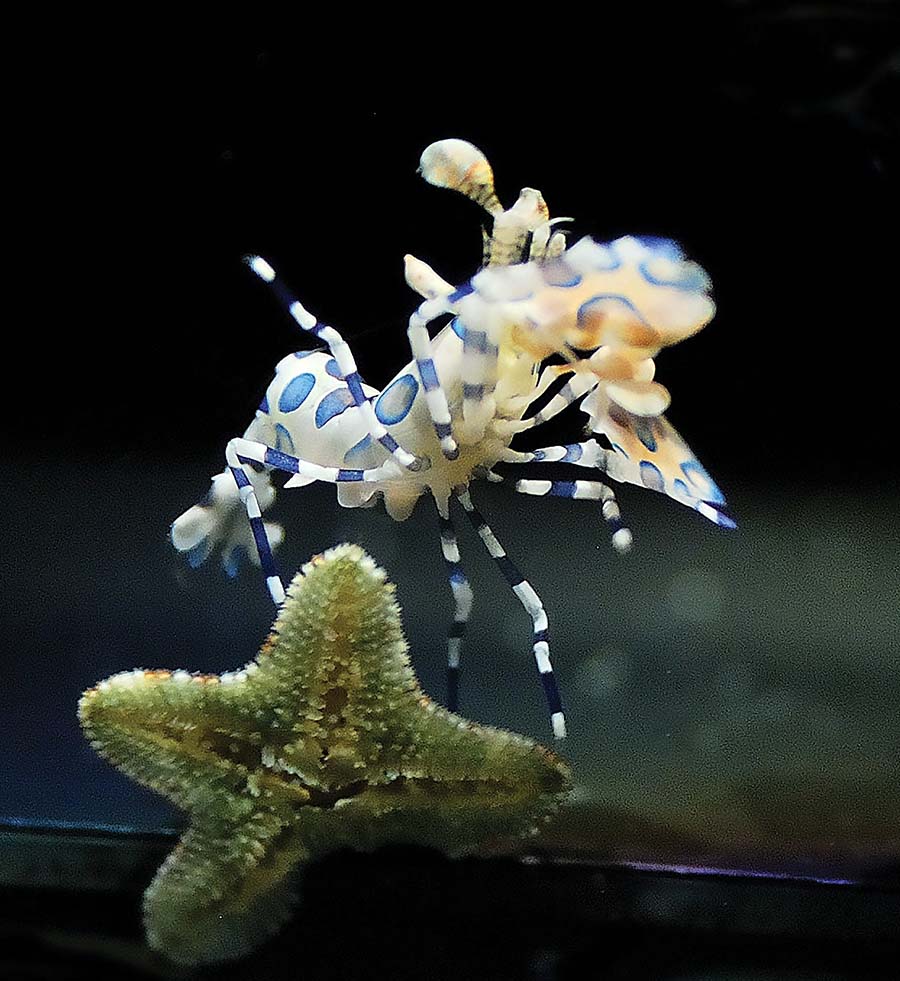
A special excerpt from the March/April 2023 issue of CORAL Magazine
article & images by Ramon Villaverde
Word of encouragement (and a warning): “Rearing of Harlequin Shrimp is fairly easy compared to other pelagic invertebrate larvae I have worked with…”
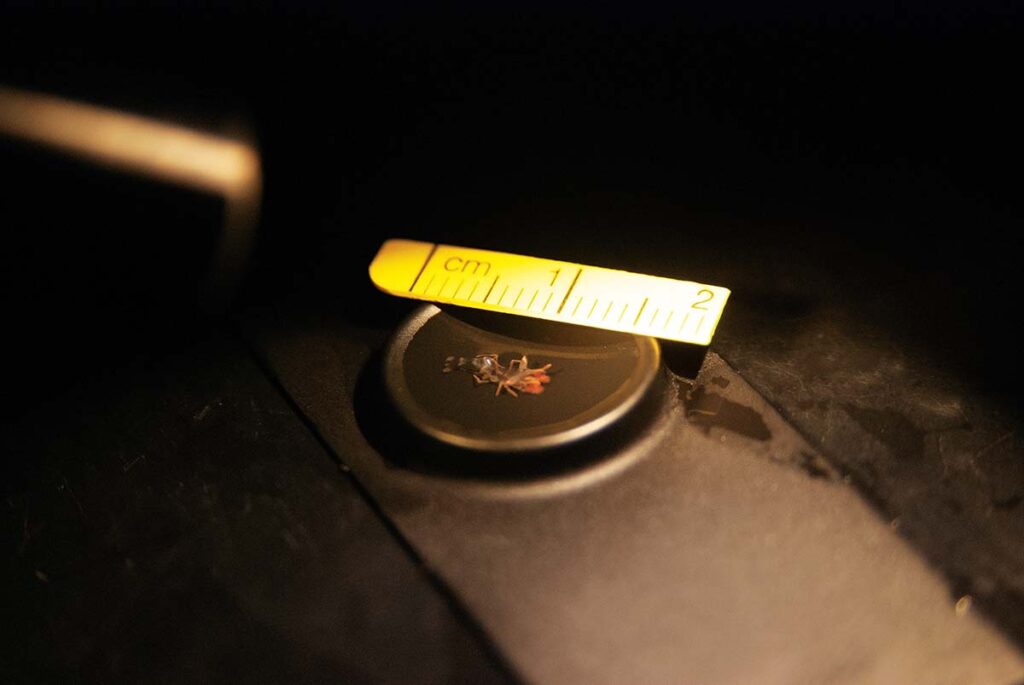
SEVERAL YEARS AGO, I was given the opportunity to rear two clutches of Harlequin Shrimp (Hymenocera picta) larvae, thanks to Greg Smith of Aquatic Technology in Columbia Station, Ohio, who was actively breeding the species and provided me with extra larvae. In my career as a professional aquarist I had never had the opportunity to work with the adults, let alone the larvae of these specialized feeders, but I was fortunate enough to successfully settle the planktonic larvae and learn a few things along the way.
There are several things that someone wanting to aquaculture pelagic larvae, teleost or invertebrate, should be prepared for before having the actual larvae. One should have a good supply of live foods, both phytoplankton and zooplankton (depending on the species to be reared). You should have an appropriate larviculture vessel, or, if approaching a new species with unknown rearing techniques, many different designs, including a kreisel, pseudo-kreisel, cone tank, black round tank (BRT), or some DIY variation of these specialized tanks, which are made to keep planktonic larvae suspended in the water column.
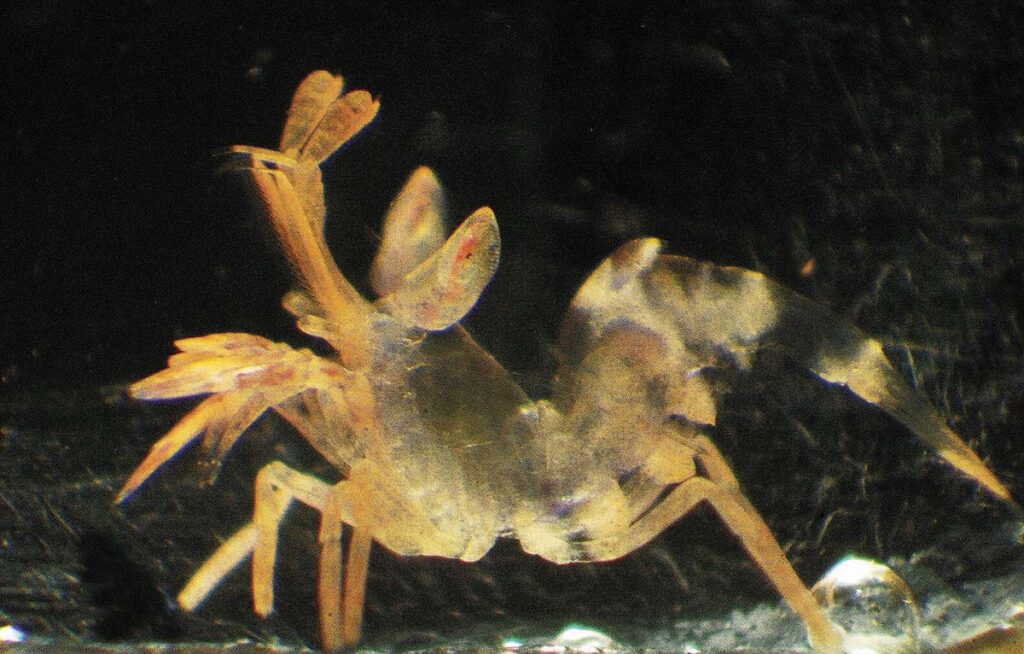
Support equipment should also not be overlooked; makeup water, nets and various micro-screens, flashlight, cups, and pitchers or beakers are all important and useful. If possible, a simple microscope or dissecting scope can be a very important tool. For me, having access to both types of microscopes was invaluable to monitor and evaluate the culture tank water, as well as diagnosing the health of my larvae.
At the time, I was already working with some other fish and invertebrate larvae, so I had several species of algae and copepods as well as Artemia on hand for live food. I also had a BRT available to utilize as the larval tank. My first thought was that the BRT may not be the right type of larval tank for shrimp larvae, but I was wrong. I had based my opinion on my experience raising peppermint shrimp (Lysmata sp.), whose larvae need more of a kreisel or cone tank design to help keep them suspended in the water.
The BRT was 24 inches (60 cm) in diameter by 12 inches (30 cm) in height, with a bulkhead in the bottom center of the tank for drainage. Inside the tank, and attached to the bulkhead, there was a 2-inch-diameter screen for drainage with a silicone airline that was attached around the base of the screen to create an air curtain around the screen. The air curtain served two functions: first to help deflect the plankton off the screen and the second to create the circular upwelling flow desired to keep the larvae and food suspended in the water. Attached to the outside of the bulkhead there was a nipple adapter attached to silicone tubing that was of adjustable height to control the water level in the tank. Water from the filtration to the larval tank was added with a valved line to allow for adjustment of the amount of water circulated from the filtration system to larval tank.
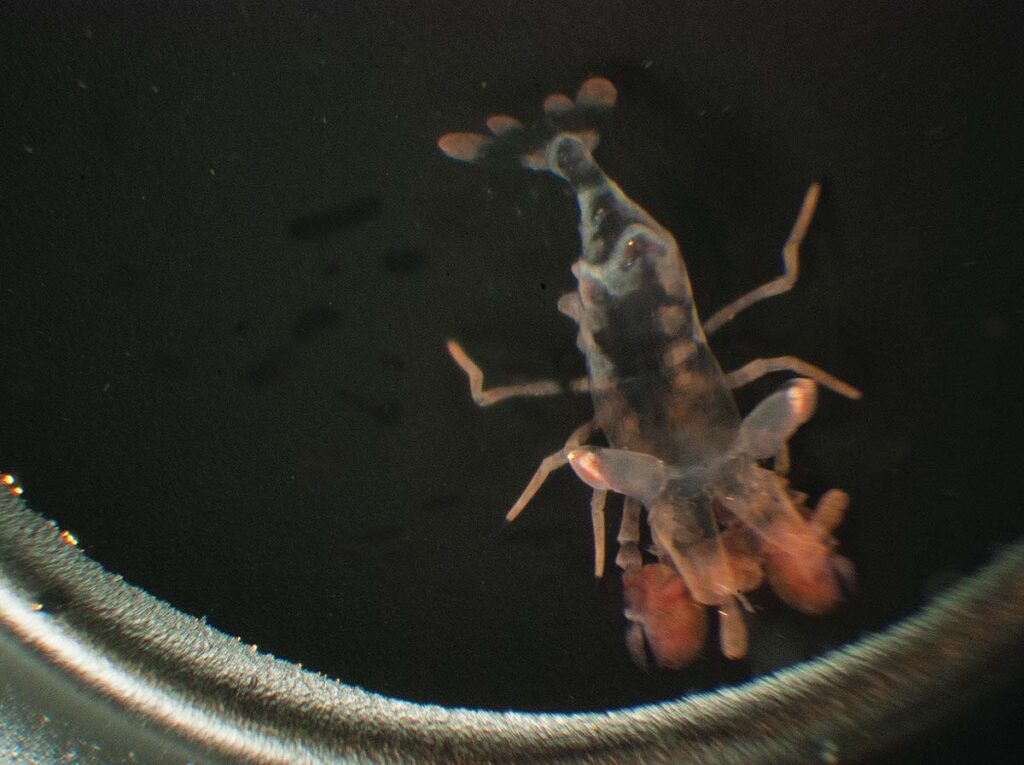
Rearing of Harlequin Shrimp larvae is easy compared to other pelagic invertebrate larvae I have worked with. The larvae are competent swimmers, and they maintained their desired position in the water column with little need of a strong upwelling flow. Daily tasks included checking the water flow and condition, siphoning off waste and detritus, feeding, and resetting algae drip into the tank.
Fine adjustments need to be done to the flow of water going into the larval tank, as well as adjusting the height of the drainage to maintain the desired water level. Removal and cleaning of the drain screen was also important in water level adjustment.
Siphoning the bottom of the tank was probably the most labor-intensive part of the rearing process in the beginning. I dripped in phytoplankton fairly heavily in the beginning and lessened the amount as time went on. I observed that the algae density in the tank could remain light and was even beneficial in stopping an issue which I will explain in a moment. The air curtain around the drainage screen had to be turned down or off to be able to see the bottom and avoid siphoning the larvae. The siphoning process was slow: I had to move slowly so as not to bump the larvae with the siphoning tube, as well as stir up the detritus I was trying to remove.
Feeding the larvae was not a daily occurrence, since I decided to co-culture copepods with the shrimp larvae. Co-culturing lessened the burden on my live food cultures. I included Parvocalanus, Apocyclops, and Euterpina copepods in the larval tank. Also, 24- and 48-hour-old Artemia nauplii (baby brine shrimp) were fed on occasion. I suspect you could raise Harlequin Shrimp using only Artemia as a larval feed, but I presume you would have better survival with the more nutritious copepods. Out of the three types of copepods I utilized, Apocyclops would be the easiest to culture. I would look at the system water with a flashlight to check for my food density and supplement the amount in the water when I thought the population was low.
I mentioned previously that I had an issue with the larval tank. Over the course of a week, I noticed I was having higher than usual shrimp mortality. Looking at several of the dead larvae I found a heavy load of Vorticella (ciliates also known as Bell Animacules) growing on the larvae. I assume the Vorticella attaching to the exoskeleton of the larvae inhibited their molting process as well as irritated the larvae, causing them to be unable to molt. To resolve the problem, I performed extra cleaning and siphoning of the side and bottom of the BRT to remove and lower the population of Vorticella, and I also lessened the amount of algae and live food added to the tank. The duration of the larval phase in Harlequin Shrimp ranges from as little as 40 days to well over 60 days post-hatch. Most of the larvae I worked with settled between 50–60 days post-hatch. After settlement, the shrimp require echinoderms for survival due to their specialized obligate diet. Fortunately for me, I had a steady supply of Asterina starfish I could harvest from several large coral systems. Shrimp that I reared started to mate and hold eggs around 330 days post-settlement.
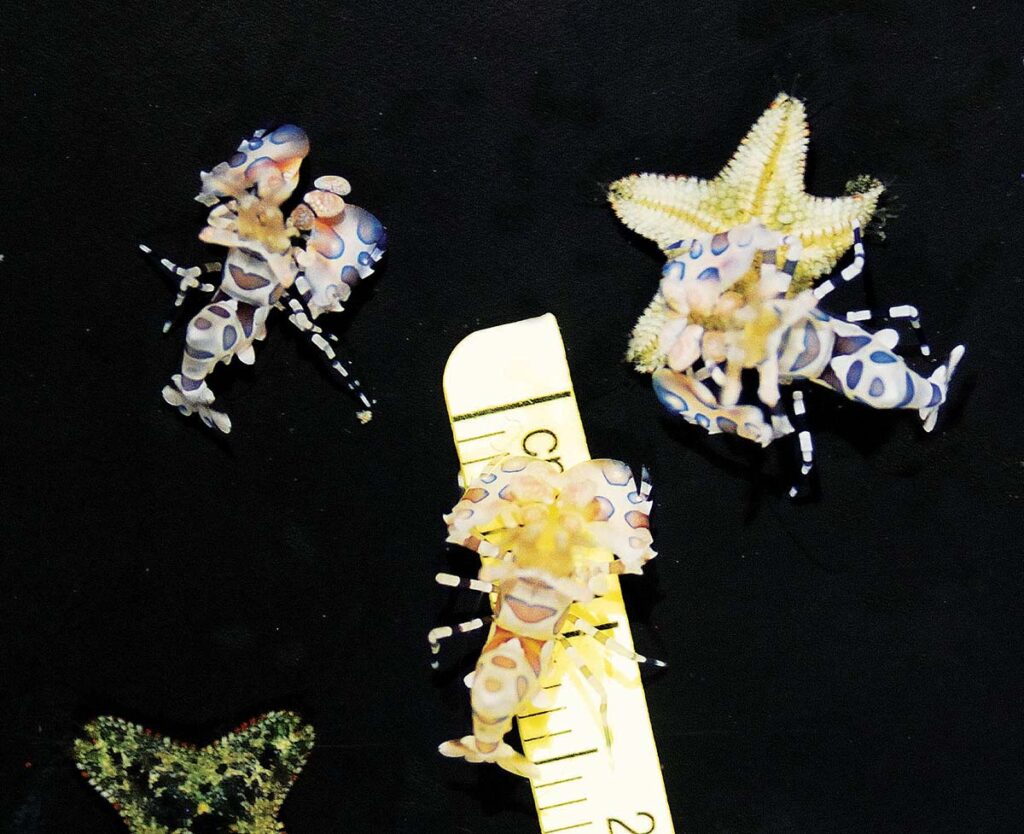
Final Words For The Would-Be Breeder
If you are interested in breeding these unique shrimp, you should have a plan in place well before acquiring them. Their specialized obligate diet will be the most challenging aspect of keeping them. You will need a steady supply of echinoderms, obtained either by purchasing them or, if you are fortunate enough, you may have a prolific breeding population of Asterina starfish. I went through about four Asterina per shrimp every week.
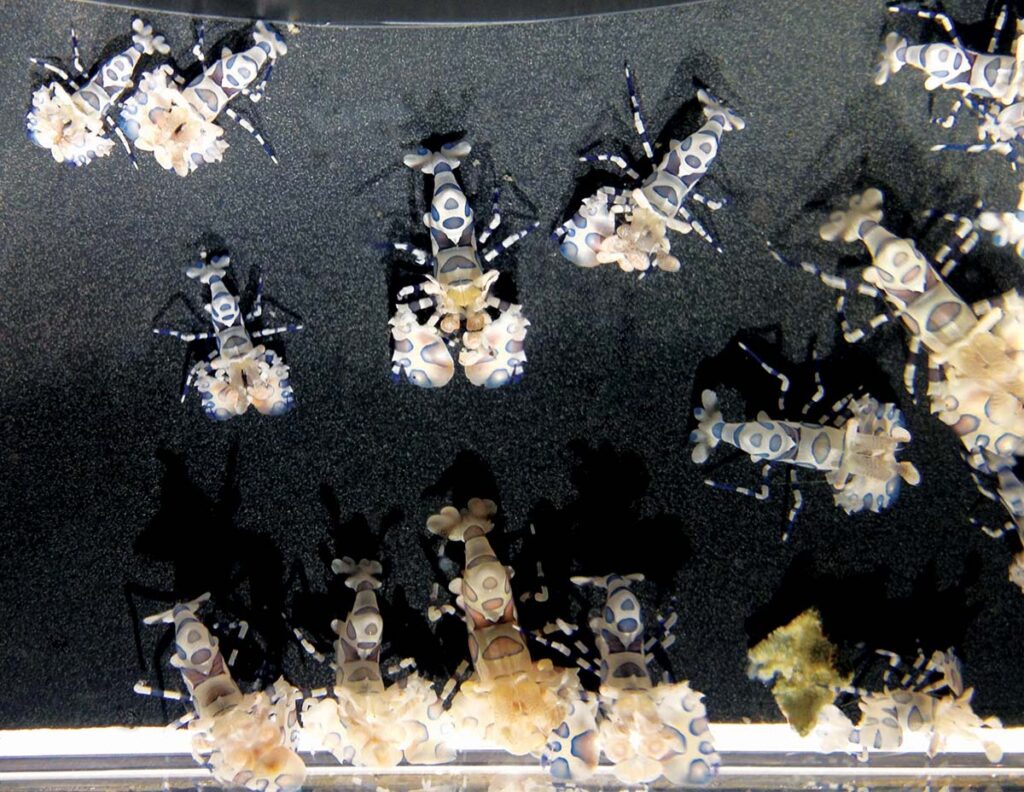
Harlequin Shrimp are not always available but can be sourced from reputable aquarium distributors. When you have sourced shrimp for your breeding venture, it is best to start with only a pair due to aggression issues you may encounter among cohorts. Harlequin Shrimp are easily sexed; females are larger and have blue markings on the pleopods (swimmerets) on the underside of their abdomen (tail); males are smaller and lack these markings.

Harlequin Shrimp will spawn and hold a new clutch of eggs about every 3 to 4 weeks concurrently with their molt cycle. Although I have not personally counted clutch size, the literature states that clutch size can vary from several hundred to several thousand eggs. I did not attempt to rear the F2 larvae produced by my F1 offspring due to the ethical concerns of not having a steady food supply for the settled larvae and lack of demand from other public aquarium facilities due to their specialized diet.
Ramon Villaverde is the Aquatic Projects Keeper and Dive Safety Officer for the Columbus Zoo and Aquarium, Columbus, Ohio, and has been a professional aquarist for 26 years.





Hello Ramon,
Thank you for your Harlaquin rearing article. Is it possible for you to email me a diagram of the vessel you describe you designed for rearing the young Harlaquin’s. I have failed twice in my attempts to rear my pairs clutch beyond 4 days. Thank you.